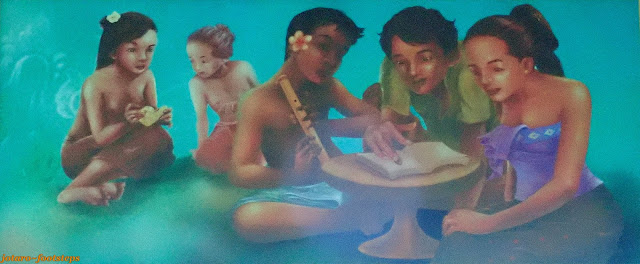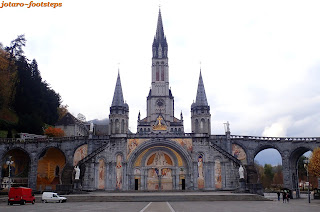You are at - Jotaro's Blog / Footsteps / Art Gallery / Indonesian Art / Balinese Art 2018 / Bali International Airport / Hall 7 | Go to H3&5/H4/H6/H8/H9B
Footsteps - Jotaro's Travels
BALINESE PAINTINGS AT BALI INTERNATIONAL AIRPORT: Hall 7 - Balinese Community
Bali, Indonesia - November 2018
While on a cycling trip in Bali, on an invitation by the Brompton Owners Bali group, we visited several places. Bali is an island full of art, whether at its attractive temples, palaces, water parks or just around any corner. And we saw many beautiful pieces. even as we were waiting to board our return flight, at the International Departure Halls of the Bali Ngurah Rai International Airport.
Below are some of the paintings that we saw at Halls 7. Most of the paintings depict casual communal activities including rural markets in Bali. The above painting shows young, country ladies collecting water from a nearby spring for their daily use. "Balinese are very connected to the element of water, not only to the rains from above, but water is all around - in springs, rivers, lakes, fountains, ponds, - so much that it became part of their religion, which used to be commonly called Agama Tirta.Due to photography angle, and for presentation purposes, many of photos have been cropped and edited to compensate for low lighting. It is better to go there and see these artwork for yourself. Enjoy!
This is page 4 of a 6-page blog, Click Here To Go To Main Page.
Praying at a Sanggah (traditional house temple). The sanggah is always positioned outside, in the corner of the family compound which is most mountain-wards (in the direction of Mt. Agung).
Here, the family will pray to God, known as Ida Sang Hyang Widhi in Balinese, other Godly manifestations (dewa or bhatara) and the family ancestors (leluhur). A number of ceremonies are performed at the family temple. They are known as upacara yadnya and examples of these are – tooth filings, weddings, exorcisms, or temple anniversaries. The total number of shrines in a sanggah varies according to the beliefs of the particular family, however they must include a shrine called padmasana (where one offers prayers to God), a shrine to pray for artistic inspiration (taksu), a shrine for ancestral worship, and one shrine called Rong Telu. Outside the temple there should also be a shrine called Penunggun Karang, which is believed to be the place where the spirits who guard the family temple, the family and their compound, reside.
Market fruit and vegetable stalls; the stalls also sell Balinese rattan-ware for household use.
A popular place to get avian pets is at the Bali Satria Bird Market in Denpasar. Although one should note that Pet bird trade endangering Indonesian birds., and a similar report on the Endangered Birds of Bali. Perhaps it would be better to view these birds at the
Bali Bird Park which also has a large displays of reptiles and amphibians.
Market patrons relaxing at stalls selling nasi timbel or nasi jinggo.
Nasi timbel is steamed rice wrapped in a roll in banana leaves. The heat of the hot-cooked rice touches the banana leaf and produces a unique aroma, it is often served with various side dishes such as fried chicken, empal gepuk (fried beef), jambal roti (salted fish), tahu goreng, tempeh, salted duck egg, sayur asem, with lalab and sambal.
Nasi jinggo is served in a banana leaf package, containing a handful of white rice with side dishes and chili sauce and is an affordable quick eats. The side dishes are typically tempeh, deep-fried anchovies with peanuts fried with sambal, serundeng (sautéed grated coconut), and shredded chicken. It is almost similar with the Malaysian Nasi Lemak except that the rice is not steamed with santan.
Like most Asian street markets, there are stalls selling non-food items like clothes, bags, etc.
Balinese bridal procession on sedan.
This is part of the wedding ceremony, click here to read more details of the ceremony.
Balinese villagers making thatched Attap roof.
Attap houses are traditional village houses with thatched roof made from palm fronds - very often with Nipa fronds - together with bamboo slats as the spine and bamboo strips for weaving the fronds.
In Bali, ijuk (black aren fibers), dried coconut or rumbia leaves are often used too. The ladies are delivering the fronds while the men do the weaving.
Delivering cut stone blocks for building walls of Balinese houses. These stones are either sandstone or pumice; while sandstone and andesite stone are usually carved as ornamentation.
Click here to read more of Balinese Architecture, which includes other buildings like temples, etc.
There are many types of Balinese offering (Banten); ranging from the oft seen small Canang Sari to the more complicated Madya or Utama.
The women seen above are carrying the Banten Tegeh (tall offering) which is probably the most spectacular offering that you can find in Bali. If you ever see Balinese ladies carrying a mountain of foods or fruits on their head while walking to the temple, this is it. Mostly Banten Tegeh are presented during the celebration of the village temple “Odalan”. To create this offering the process is a bit more complicated, starting by creating a stable base made of wood, and a pike in the center which later will be impaled by the banana stem as the media to stick all the food using bamboo skewers. Last but not least, a Canang Sari will be placed on top of this mountain of food.
These stall should sell most of Bali's favorite fruits.
Delivering Balinese pottery with a wooden cart.
Bali has a long pottery history; around the 13th to 15th century, the Majapahit kingdom developed its terracotta art. Numerous clay and terracotta artifacts have been discovered, especially from Trowulan, Majapahit's former royal capital.
These days many of the sculptures & pottery seen at Balinese shops are often made in Jogjakarta.
Horses were helpful in Bali's early development,
especially the Bali Pony.
Its roots are unknown, although one theory is that ponies of ancient stock were brought to Indonesia by the Chinese in the 6th century. If this theory is true, the Bali pony would owe much of its roots to the Mongolian horse.
In addition to the Mongolian horse, it is known that some Indian stock were taken to Indonesia (although it is unknown exactly which breeds), and the Dutch also brought various eastern breeds to the country during the 18th century. Therefore, the Bali Pony likely has been influenced by both the Mongolian horse, and various other eastern breeds.
Back to contemporary times, horse riding is picking up on the island - several riding clubs offer horse riding ride packages that goes along the hills, through the grassy countryside, towards the volcanic sand coast and splashing through the waves along the beaches.
Beautifully decorated, covered dokar or cikar horse-carraiges are getting to be rare due to the traffic congestion. But the smaller Cidomo could still survive if tourist trade picks up.
Cow carts are often the mode of transport at the rural areas; here a family rides on the cart that's also filled with sacks of goods.
But the real "work horse" (pun intended) are the bigger bullocks and oxen which are stronger and can pull heavier loads - notice the larger wheels of the bullock cart above.
But the quiet transportation is transformed into Makepung racing carts. The Makepung races are held every two weeks throughout the dry season, always on Sunday.
From the land, we swing outwards to the sea to see these jukung, the Balinese out-rigger fishing boat. These colorful boats can be seen parked on the beaches or just out of the shore-line.
Larger fishing boats, moored at sea during dusk. These boats large than the juking, can go further out. Click here for a list of different types of Indonesian boats.
This is page 4 of a 6-page blog, Click Here To Go To Main Page.
___________________________________________________________________________________
Related Blogs:
 |
 |
 |
 |
 |
___________________________________________________________________________________
You may also like :
 |
| Thailand 2013 : July 2013 A quick, crazy one nighter to Bangkok but we managed to cover temples, an art museum, local markets & shopping malls. |
 |
| Street art Grand Lane in Perth, Australia - August 2019. |
 |
 |
 |
 |
 |
You are at - Jotaro's Blog / Footsteps / Art Gallery / Indonesian Art / Balinese Art 2018 / Bali International Airport / Hall 7 | Go to H3&5/H4/H6/H8/H9B
If you like this, view my other blogs at Jotaro's Blog
(comments most welcomed below. if you like this pls share via Facebook or Twitter)










































































